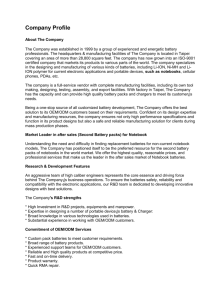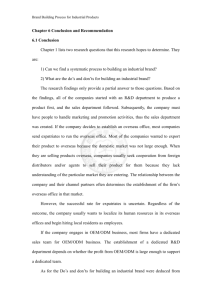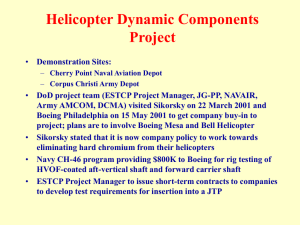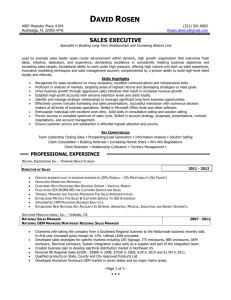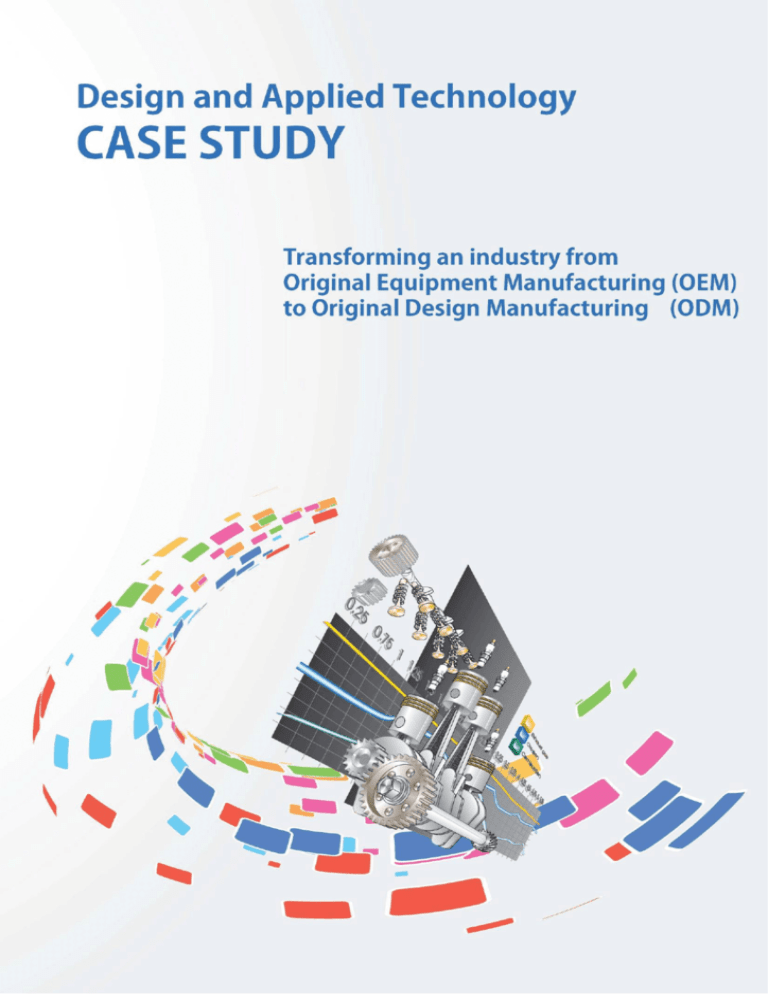
Case Study – Transforming an industry from OEM to ODM
CASE STUDY
Design and Applied
Technology
Students should be made aware of the relevance of the technology they are
studying to the real world. Case studies on technology and design enable
students to put their learning into an authentic context.
Authentic Context: Students could explore entrepreneurship and enterprise
through a case study on the transformation of
enterprises in Hong Kong.
Topics Covered:
Compulsory Part
Strand 3 : Value and Impact
Elective Part
Module 3 : Design Implementation and Material Processing
f
1
Case Study – Transforming an industry from OEM to ODM
Author
Mr Li Yu-wai
Head of Department (Design and Technology)
Tang Shiu Kin Victoria Government Secondary School
Project Coordinators
Mr Li Yat-chuen
Senior Training Consultant
Institute of Professional Education And Knowledge, VTC
Mr Tsang Siu-wah, Ephraim
Training Consultant
Institute of Professional Education And Knowledge, VTC
The copyright of the materials in this Case Study belongs to the Education Bureau of
the Government of the Hong Kong Special Administrative Region.
Duplication of materials in this Case Study may be used freely for non-profit making educational
purposes only. In all cases, proper acknowledgements should be made. Otherwise, all rights are
reserved, and no part of these materials may be reproduced, stored in a retrieval system or transmitted
in any form or by any means without the prior permission of the Education Bureau of
the Government of the Hong Kong Special Administrative Region.
© Copyright 2010
Note by the Institute of Professional Education And Knowledge, VTC:
Every effort has been made to trace the copyright for the photographs and images in this Case Study as
needed. We apologize for any accidental infringement and shall be pleased to come to a suitable
arrangement with the rightful owner if such accidental infringement occurs.
2
Case Study – Transforming an industry from OEM to ODM
Introduction
Mainland
China
has
been
renowned
worldwide as a World Factory in recent years.
Most say that it is contributed to the Hong
Kong Enterprises who work diligently and
laboriously almost 24 hours per day behind
the scene.
Since the 80’s, most Hong Kong factories had moved into Delta Pearl River
(DPR) region of Mainland China because of lower cost of land, transportation
and materials. As cost is reduced, the scale of Hong Kong manufacturers have
gained a rapid expansion in term of factory floor area, production capacity,
labors and facilities. However, after the successful application of Mainland
China to World Trade Organization (WTO) membership, the immense
domestic market of mainland China will be opened to international markets.
This will certainly benefit those Hong Kong enterprises that had been rooted in
DPR for over decades and planned to penetrate the local market there.
However, many recent research findings stated that if Hong Kong enterprises
keep on their role at the lower end of production chain that focus on the labor
intensive, energy consuming mode of production at the low-end of China’s
domestic market, the competitiveness of Hong Kong enterprises will diminish
gradually in the coming future.
Now you are working in a consultancy firm, you have just assigned a task to
study the following areas:
(1) Identify
key
successful
factors
for
an
Original
Equipment
Manufacturing (OEM) enterprise to develop into an Original Design
Manufacturing( ODM ) business model and
(2) Identify the barriers that an OEM enterprise must need to overcome
before successfully developing into the ODM business nature.
3
Case Study – Transforming an industry from OEM to ODM
The Story
The diagram below is the banner from a local manufacturer webpage.
Figure 1
Advertisement of an OEM/ODM company
Activity 1
According to the content in this advertisement to answer the following
questions.
(1) Can you get some ideas of
what OEM and ODM are?
4
Case Study – Transforming an industry from OEM to ODM
(2) What are the major differences of
OEM and ODM?
What is OEM?
OEM is short form for Original Equipment Manufacturing. One company uses a
component of another company within its product, or sells the product of
another company under its own brand. OEM refers to the company that
originally manufactured the product.
Acceptance
Requirements
Product
Design
Acceptance
Sampling
Testing
Improve
Process
Acceptance
Production
in small batch
Production
in small batch
Manufacture
Figure 2
Sample/
Prototype
Testing
Delivery to
Customers
Customer
Workflow of OEM Business Model
5
Case Study – Transforming an industry from OEM to ODM
What is ODM?
An Original Design Manufacturer (ODM) is a
company which manufactures a product which
ultimately will be branded by another firm for
sale. Such companies allow the ODMs to
produce the products without the need to
engage in the management and the running of
a factory. ODMs have shown a remarkable
increase in size in recent years. Many of them
have the capacity to handle production for
multiple clients.
ODM is quite popular in international trade, where a local ODM is used to
produce goods for a foreign company. This may be the cases where local
ownership laws restrict or prohibit direct ownership of the factory by foreigners,
but allow a local factory to produce products for a foreign company brand. The
products will be produced for either local domestic market or export to the
original foreign countries.
Hong Kong manufacturers, especially in Delta Pearl River, have achieved very
good results in establishing OEM operations in past decades. However,
competition from manufacturers of other Asian countries, such as Vietnam and
Indonesia, has been rising. To sharpen our edge and stay ahead of other
competitors, many Hong Kong manufacturers are in the high time to think of
shifting an OEM operation to ODM and even the brand name production.
6
Case Study – Transforming an industry from OEM to ODM
New Project Initiation
Overall Project discussion
Define detailed Product Specifications
Solicit Quotation
Research and Design
Design and development of
Prototype at R&D center
Sample full function test
Purchase
Order
Manufacturing
Batch manufacturing at factory
Production assembly
Quality Control and Assurance
Test by Quality Assurance LAB
Burn-in tests
Full function tests
Service and Support
Logistic services
After-sales support
Manufacture
Purchase
Order
Customer
Figure 3 Workflow ODM Model
7
Case Study – Transforming an industry from OEM to ODM
Example of popular OEM product
Figure 4 OEM product of mobile phone batteries
Nowadays, most students may have their own mobile phones. The popular
brand names are NOKIA, Samsung and Sony Ericsson. However, do you
know that the batteries used by each cell phones are usually not made by the
mobile phone companies themselves? The manufacturing of batteries are so
specialized that they need specific technology and production facilities, which
involves a huge sum of capital investment. The mobile phone companies will
only focus on their own product designs and market. They will not invest in
production of batteries, as it will not directly affect their sales and not their
specialty.
Therefore,
mobile
phone
companies
will
provide
product
specifications and outsource battery that is appropriate to their mobile phones
from a dedicated or a pool of battery manufacturers. The mobile phone
companies will require the battery manufacturer to print their trademarks onto
the batteries and make them becomes part of their products for sales. The
battery here is an OEM product. The factory produces the battery conforming
to the client requirements is doing an OEM business.
In practices, the battery manufacturer can also be an ODM business. They can
develop a new item and solicit the mobile phone companies to adopt their new
battery products.
8
Case Study – Transforming an industry from OEM to ODM
The battery manufacturer can be an Own Brand Manufacture if they sell their
batteries directly to the market with their own trademark.
Figure 5 Common OEM products of Memory Cards
Beside mobile phone battery, memory cards are also OEM items commonly
available in the market. The manufacturer produces all ranges of memory
cards according to different user requirements, such as the memory capacity,
reliability and packaging design. The memory cards will be printed with the
brand names of different clients for sales. Once the products are shipped out,
the role of the OEM will be completed.
9
Case Study – Transforming an industry from OEM to ODM
Activity 2
The diagram below is the statistic results made by the Hong Kong Productivity
Council in 2007 about the nature of business in Hong Kong manufacturer.
Figure 6
Distribution of Hong Kong Manufactures Business Models
(1) Can you give any daily examples of OEM and ODM products?
10
Case Study – Transforming an industry from OEM to ODM
(2) What is “Own Brand” manufacturer? Can you suggest one
example for illustration?
(3) What conclusions can you make from the data in the diagram?
11
Case Study – Transforming an industry from OEM to ODM
Activity 3
The diagram below is a survey result about the reasons for transforming an
OEM to ODM business.
Figure 5 Reasons of adopting ODM Business Model
1. Why ODM can be more proactive in selling?
__________________________________________________________
__________________________________________________________
__________________________________________________________
__________________________________________________________
__________________________________________________________
__________________________________________________________
12
Case Study – Transforming an industry from OEM to ODM
2. Why ODM can have higher profit margins?
__________________________________________________________
__________________________________________________________
__________________________________________________________
__________________________________________________________
__________________________________________________________
__________________________________________________________
3. Why ODM will have less competition compared with OEM?
__________________________________________________________
__________________________________________________________
__________________________________________________________
__________________________________________________________
__________________________________________________________
__________________________________________________________
4. Why ODM can have more potential customers worldwide?
__________________________________________________________
__________________________________________________________
__________________________________________________________
__________________________________________________________
__________________________________________________________
__________________________________________________________
5. Why ODM can have higher sale volume than OEM?
__________________________________________________________
__________________________________________________________
__________________________________________________________
__________________________________________________________
__________________________________________________________
__________________________________________________________
13
Case Study – Transforming an industry from OEM to ODM
6. Why ODM can entry into new market?
__________________________________________________________
__________________________________________________________
__________________________________________________________
__________________________________________________________
__________________________________________________________
__________________________________________________________
14
Case Study – Transforming an industry from OEM to ODM
Factors to be considered from OEM to ODM
Product positioning, promotion, marketing
channel and strategy are the most
important factors for the transformation of
an OEM to ODM. However, to most
industrial entrepreneurs, all these factors
are usually not their strengths and scope
of business. Therefore, they are really in
need of external advices and consultancy
when they start to think of developing
their ODM business.
Undoubtedly, OEM companies usually have leading production and
engineering capabilities. However, when considering transformation of OEM to
ODM, they have to enhance their marketing and product strategies.
Developing these marketing and product strategies can be a very complicated
matter to most OEM manufacturers, as they usually do not have experience
and sense of fashionable trends.
In the past, they only focus on technical and engineering aspects of how to
produce a product according to the clients’ specifications. Their major concern
is to keep the cost to minimum whist the quality of products can be met. The
product can either sell or not in the foreign or local market is totally not their
concern. However, if the company is changed to an ODM, they will need to
take care of the following operation:
1.
Business Planning (e.g. marketing strategy, product portfolio,
technology roadmap, design trends, ‘make or buy’ decisions and
Human Resources planning);
2.
Sales Planning (e.g. market identification, which products? when to
market? Sales targets, product features, product planning, quality
15
Case Study – Transforming an industry from OEM to ODM
and design);
3.
Product Planning (e.g. product features, pricing, decide to go to
ODM or OEM);
4.
Design and prepare Product Launch Program
The future development of ODM is told to be so promising and deterministic
but why many companies are still hesitating in developing into this business
model? There are some barriers hindering the OEM companies at this moment.
For most OEM manufacturers, “Don’t know the market needs” was the major
barrier for OEM to become ODM. In addition, “Cannot afford high design
investment costs” and “High market risk” also make the transformation
hindered. OEM producers are used to make contact with only a few major
overseas customers. They do not have marketing and sales network to sell
their own products or concepts if they have transformed to ODM.
For the preparation of final presentation, students are expected to conduct a
SWOT (Strength, Weakness, Opportunity and Treat) analysis for both the
OEM and ODM.
16
Case Study – Transforming an industry from OEM to ODM
Activity 4 SWOT analysis (OEM)
Task:
Conduct a primary study for the Strength, Weakness, Opportunity and Threat
analysis of OEM business model.
Strength of OEM
Weakness of OEM
17
Case Study – Transforming an industry from OEM to ODM
Opportunity of OEM
Threat of OEM
18
Case Study – Transforming an industry from OEM to ODM
Activity 5 SWOT analysis (ODM)
Task:
conduct a primary study for the Strength, Weakness, Opportunity and Threat
analysis of ODM business model.
Strength of ODM
Weakness of ODM
19
Case Study – Transforming an industry from OEM to ODM
Opportunity of ODM
Threat of ODM
20
Case Study – Transforming an industry from OEM to ODM
Activity 6
Group Discussion and Presentation
Task:
Discuss and prepare a group presentation
about
(1)
Key success factors for OEM to
become ODM; and
(2)
Barriers for OEM to be overcome to
become ODM.
Guidelines:
Introduction
State the background of Hong Kong industry in this decade and the business
model of most Hong Kong manufacturers.
What are the threats of OEM? And Why??
What happens to the existing OEM enterprises? List their challenges they are
facing with.
What are the advantages of ODM?
List the advantages of ODM and give one or more successful examples for
elaboration.
How to become an ODM enterprise??
List the factors to be considered when transforming into an ODM industry.
21
Case Study – Transforming an industry from OEM to ODM
We encourage collaborative learning throughout this case study; therefore
peer assessment and evaluation on their learning were suggested. It is
recommended that you take a minute to evaluate and reflect on your own
leaning after each lesson.
A simple checklist rubric is provided. You will
also take responsibility to assess the performance of other groups during the
final presentation with the scored rubrics.
Self / Peer assessment (checklist)
This assessment rubric can be used to keep your learning progress and
schedule.
Put “Yes” or “No” after each lesson. Teacher can easily check
whether you can meet the lesson objectives.
Student Name: __________________
Team: _________________
Focus of Assessment: Teamwork
Criteria
Date: ____/_____/_________
Self
Peer
Teacher
1.
I understand the lesson objectives.
Yes / No
Yes / No
Yes / No
2.
I work with team members cooperatively.
Yes / No
Yes / No
Yes / No
3.
I give my views responsibly.
Yes / No
Yes / No
Yes / No
4.
I respect and listen to other members’
Yes / No
Yes / No
Yes / No
ideas.
5.
I can draw conclusion after this lesson.
Yes / No
Yes / No
Yes / No
6.
I am satisfied with my learning today.
Yes / No
Yes / No
Yes / No
22
Case Study – Transforming an industry from OEM to ODM
Assessment rubrics (Presentation)
Students can use these rubrics for peer assessment of the final presentation.
Teacher needs to explain and discuss these criteria with the students.
Peer Assessment for Final presentation
Team:
Date:
Assessors:
Class:
Presentation
Attitude
Knowledge
Focus No
___/___/ ______
Scores
Assessment Criteria
Scores
1
1 2 3 4 5
← Understanding of the topic →
6
7
8
9 10 N/A
2
1 2 3 4 5
← Content is consistent with the topic →
6
7
8
9 10 N/A
3
1 2 3 4 5
← Content is supported with evidence →
6
7
8
9 10 N/A
4
1 2 3 4 5
← Content is at appropriate level →
6
7
8
9 10 N/A
5
1 2 3 4 5
← Show key concept in content →
6
7
8
9 10 N/A
6
1 2 3 4 5
← Show effort in group discussion →
6
7
8
9 10 N/A
7
1 2 3 4 5
← Show effort in information search →
6
7
8
9 10 N/A
8
1 2 3 4 5
← Show effort in preparing presentation →
6
7
8
9 10 N/A
9
1 2 3 4 5
← Show competency in IT skills →
6
7
8
9 10 N/A
10 1 2 3 4 5
← Show organization skills →
6
7
8
9 10 N/A
11 1 2 3 4 5
← Present their views and idea clearly →
6
7
8
9 10 N/A
12 1 2 3 4 5
← Logical and consistent flow of ideas →
6
7
8
9 10 N/A
13 1 2 3 4 5
← Have interaction with audiences →
6
7
8
9 10 N/A
14 1 2 3 4 5
← Show appropriate use of visual aids →
6
7
8
9 10 N/A
15 1 2 3 4 5
← Have eye contact with audiences →
6
7
8
9 10 N/A
Total Scores
* Performance descriptors: 1 is incomplete; 5 is fair; 7 is good; 8 is very good;
9 is outstanding
23
Case Study – Transforming an industry from OEM to ODM
References
1.
Hong Kong Productivity Council
http://www.hkpc.org/html/eng/common/index.jsp
2.
Wikipedia, the free encyclopedia
http://en.wikipedia.org/wiki/Original_equipment_manufacturer
3.
Trade development Council
http://www.tdctrade.com/
4.
Opportunity photo
http://www.forearthonline.net/earthlove/opportunity.html
5.
Threat photo
6.
http://thetrianglezone.com/ClassSafe.htm
Strength Photo
http://dir.coolclips.com/Sports/Physical_Fitness_and_Exercise/Bodybuildin
g_and_Weightlifting/bodybuilding_and_weightlifting2.html
24
Case Study – Transforming an industry from OEM to ODM
25
Case Study – Transforming an industry from OEM to ODM
26


